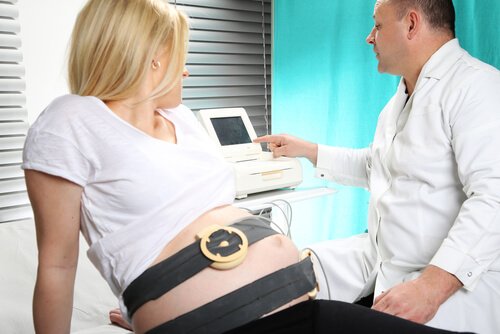What Is Fetal Monitoring and Why Is It Used?

During pregnancy, there is an important procedure that all women should perform: fetal monitoring. Of course, the goal of this procedure is to ensure and control the fetus’s health.
Fetal monitoring is a very common technique and it is achieved through the implementation of a cardiograph to check for:
- Heart rate.
- The rhythm of the heartbeat.
- The amount of oxygen the fetus receives.
- The different variations that occur in the baby’s blood flow.
- If the baby is sleeping, awake or moving to certain stimuli (such as when the mother ingests sweet foods.)
- The presence of conditions such as meningitis.
- Through this test the gynecologist can also check the maturity of the pregnant woman’s uterus.

Types of fetal monitoring
There are two different types of fetal monitoring. The first is external through which the doctors are able to check the frequency of the fetal heart rate.
How is this done? Through the use of certain sensors which are placed on a belt around the mother’s belly in an upright position.
The second technique is internal fetal monitoring, which is a little more complex than the previous method. To perform it, electrodes are placed around the fetus’s head and they receive information which is then analyzed to create a report on the fetus’s general state of health.
The drawback of internal fetal monitoring
One of the disadvantages of performing internal monitoring is how invasive it can be. The amniotic membranes must be punctured in order to place the electrodes and this could pose a high risk of infection for both mother and child.
There is also the possibility for mistakes to happen during the placement process. This could harm the fetus and the walls of the uterus. Keep in mind however, that these complications are rare.
Advantages of external fetal monitoring
According to Dr.Gabriel Cano, specialist in pediatrics, “one of the greatest advantages of external monitoring is that it is not invasive.”
In fact, it also permits the registry of frequency and intensity of the contractions that the pregnant woman is having.
External fetal monitoring procedure
To perform this test, the pregnant woman must be placed on a stretcher in a semi-sitting or semi-lying position. Then, flexible straps that have 2 transducers incorporated into them are placed around the abdomen.
- The first transducer is used to analyze the activity of the uterus.
- The second is used to check the baby’s heartbeat.
While the test is being performed, a graph is created which can be printed later.
This test can also be used to observe the movement of the baby due to external stimuli
Follow-up of fetal monitoring
During the last trimester of pregnancy, fetal monitoring should be performed more frequently. In most cases, it should be performed weekly.
Once 40 weeks of pregnancy have been reached, fetal monitoring should be performed once every 2 or 3 days until childbirth occurs.
External fetal monitoring is not complicated and the test lasts for approximately 30 minutes. During the test a special graph is created which can help detect problems and anomalies.
If the rhythm of the baby’s heartbeat is below 120 per minute, the doctors may have to evaluate his or her state of health thoroughly.

Aspects to consider
- It is not a compulsory test, however, it is very useful.
- Its realization doesn’t mean that something is wrong, it’s simply a routine checkup.
- The rhythm of the baby’s heartbeat is considered to be normal when it oscillates between 120 and 160 beats per minute.
- If the baby’s heartbeat is below 100 beats per minute, the mother is usually asked to lie on her left side in order to allow the baby to receive more oxygen.
- During a contraction it’s normal for the baseline which measures the fetal heart rate to drop. It is understood that after the contraction, if the baseline returns to its natural position, the baby is not suffering.
During pregnancy, there is an important procedure that all women should perform: fetal monitoring. Of course, the goal of this procedure is to ensure and control the fetus’s health.
Fetal monitoring is a very common technique and it is achieved through the implementation of a cardiograph to check for:
- Heart rate.
- The rhythm of the heartbeat.
- The amount of oxygen the fetus receives.
- The different variations that occur in the baby’s blood flow.
- If the baby is sleeping, awake or moving to certain stimuli (such as when the mother ingests sweet foods.)
- The presence of conditions such as meningitis.
- Through this test the gynecologist can also check the maturity of the pregnant woman’s uterus.

Types of fetal monitoring
There are two different types of fetal monitoring. The first is external through which the doctors are able to check the frequency of the fetal heart rate.
How is this done? Through the use of certain sensors which are placed on a belt around the mother’s belly in an upright position.
The second technique is internal fetal monitoring, which is a little more complex than the previous method. To perform it, electrodes are placed around the fetus’s head and they receive information which is then analyzed to create a report on the fetus’s general state of health.
The drawback of internal fetal monitoring
One of the disadvantages of performing internal monitoring is how invasive it can be. The amniotic membranes must be punctured in order to place the electrodes and this could pose a high risk of infection for both mother and child.
There is also the possibility for mistakes to happen during the placement process. This could harm the fetus and the walls of the uterus. Keep in mind however, that these complications are rare.
Advantages of external fetal monitoring
According to Dr.Gabriel Cano, specialist in pediatrics, “one of the greatest advantages of external monitoring is that it is not invasive.”
In fact, it also permits the registry of frequency and intensity of the contractions that the pregnant woman is having.
External fetal monitoring procedure
To perform this test, the pregnant woman must be placed on a stretcher in a semi-sitting or semi-lying position. Then, flexible straps that have 2 transducers incorporated into them are placed around the abdomen.
- The first transducer is used to analyze the activity of the uterus.
- The second is used to check the baby’s heartbeat.
While the test is being performed, a graph is created which can be printed later.
This test can also be used to observe the movement of the baby due to external stimuli
Follow-up of fetal monitoring
During the last trimester of pregnancy, fetal monitoring should be performed more frequently. In most cases, it should be performed weekly.
Once 40 weeks of pregnancy have been reached, fetal monitoring should be performed once every 2 or 3 days until childbirth occurs.
External fetal monitoring is not complicated and the test lasts for approximately 30 minutes. During the test a special graph is created which can help detect problems and anomalies.
If the rhythm of the baby’s heartbeat is below 120 per minute, the doctors may have to evaluate his or her state of health thoroughly.

Aspects to consider
- It is not a compulsory test, however, it is very useful.
- Its realization doesn’t mean that something is wrong, it’s simply a routine checkup.
- The rhythm of the baby’s heartbeat is considered to be normal when it oscillates between 120 and 160 beats per minute.
- If the baby’s heartbeat is below 100 beats per minute, the mother is usually asked to lie on her left side in order to allow the baby to receive more oxygen.
- During a contraction it’s normal for the baseline which measures the fetal heart rate to drop. It is understood that after the contraction, if the baseline returns to its natural position, the baby is not suffering.
This text is provided for informational purposes only and does not replace consultation with a professional. If in doubt, consult your specialist.








